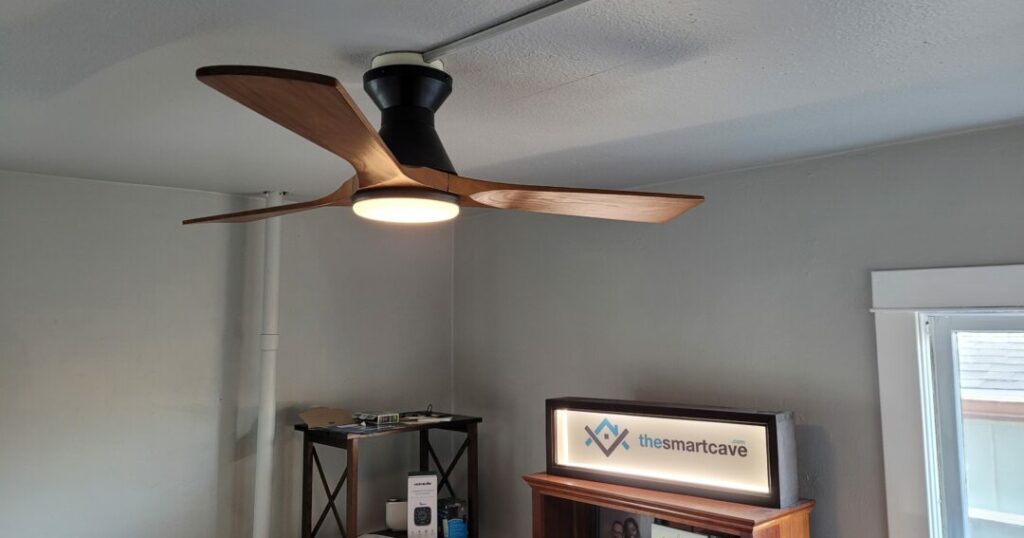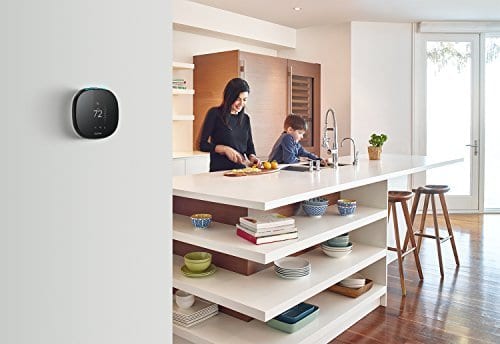Do you ever get sick of constantly wandering around your home opening and closing blinds?
The whole annoying process can be avoided with a proper smart blind retrofit kit like the ones in this article. These tilt blind kits work by attaching a motor to your blinds so that you can open or close them automatically or through smart home systems like Amazon Alexa and Google Assistant.
Best Smart Tilt Blinds
So which smart tilt blinds kit is the best? The most reasonable overall choice is the SwitchBot blinds kit due to it’s low price and simple design. However, better looking options can be had if you’re willing to spend significantly more.
E-Wand Gen. 2 Hybrid (FM and Zigbee)
Zigbee option. Twist control for manual operation.
iblinds v3 Smart Blinds Motor Kit (Charger Not Included)
Installs inside headrail of corded lift blinds. Z-Wave hub required.
Somfy Clever Tilt Blind Motor Kit
Installs inside headrail of corded lift blinds. Requires Somfy myLink hub for smart home control.
MySmartBlinds Blind Automation Kit
Includes solar charging system. Requires additional hub for voice control.
Before You Buy
Smart Integration
One of the first questions when buying a new smart device is what apps and systems will this device work with? The smart tilt blinds on this list each work with a range of different systems. The SwitchBot Tilt Blind kit works with smartphones as well as Alexa, Google Home and Siri for voice commands and remote control when not at home. MySmartBlinds work with Amazon Alexa and Google Assistant. Somfy’s Clever smart blinds kit works with Amazon Alexa, Google Assistant and IFTTT.
The E-Wand uses an open protocol that can be integrated into almost anything like Amazon Alexa, SmartThings, Google Home and IFTTT. The iBlinds use the Z-Wave protocol and are compatible with smartphone apps and popular systems like Google Assistant and Amazon Alexa.
Power Source
Another important consideration is power source. Some blind tilt retrofit kits require wired charging or batteries, while others use solar power. The SwitchBot Blind Tilt and MySmartBlinds kits recharge automatically with solar panels.The standard Somfy Clever kit uses AA battery power, but an upgraded kit with rechargeable batteries is also available. The E-Wand uses AA batteries. The iBlinds has a rechargeable battery pack that uses a standard mini USB.
Installation and Compatibility
All of the smart blind kits on this list work with the standard horizontal tilt blinds that are between 2 and 2.5 inches deep. Also, all of these blind kits only work on one set of blinds, which makes it easier to compare their value. The iBlinds, Somfy Clever and MySmartBlinds fit inside the headrail at the top of the tilt blinds, while the E-Wand and SwitchBot blind kits are installed on the outside. It is also important to note that Somfy’s Clever Tilt Blind Motor Kit includes a heavy motor and does not work with vinyl or aluminum blinds.
Smart Tilt Blind Reviews
- Compatible with nearly all blinds that include a tilt wand (cordless and corded)
- Built-in 2000mAh lithium battery with solar panel for endless charging
- Uses a high-precision motor to allow for blind adjustments to the closest 2°
- Built-in light sensor to automatically maintain a constant light intensity
- Requires SwitchBot Hub Mini for voice control and other smart home integration
SwitchBot’s Motorized Blind Tilt kit is one of the better smart blind products available. The kit grips the tilt wand of an existing set of blinds and attaches to the headrail. On command, the motorized device rotates the wand to adjust the blinds just as you would manually rotate the wand. With the SwitchBot Hub Mini, the SwitchBot Blind Tilt kit pairs with Amazon Alexa, Google Home and Siri for voice commands and remote operation when not at home.
What I Like
- It’s compatible with nearly all wand control horizontal blinds. Some of the other smart blind tilters are mounted inside the headrail and are not compatible with cordless blinds because the cordless mechanism takes up too much space inside the headrail. The SwitchBot Blind Tilt avoids this problem because it attaches directly to the existing wand and mounts to the outside of the headrail.
- It’s less expensive. At roughly $70 per window, it’s certainly not cheap. But it’s about half the price of the next lowest cost product on this list. Once you multiply the difference over several windows, the price difference becomes quite significant.
- The motor on these smart blinds is recharged through an attached solar panel, which means you’ll never have to worry about charging the SwitchBot or replacing its batteries.
What I Don’t Like
- It doesn’t look the greatest. It’s a big, clunky looking device stuck to the inside of your blinds. It’s especially noticeable if your blinds are any color other than white.
- You need a SwitchBot Hub Mini to connect the SwitchBot Blind Tilt to popular smart home systems. Although it’s an extra cost, it’s relatively inexpensive (~$40). If you need multiple Blind Tilts for multiple windows (like most people do), you still only need one SwitchBot hub. In that case, the “per window cost” of the hub gets even smaller.
For me, the main issue I have with “hub required” is that it’s yet another hub/bridge to add to my ever growing collection.
Verdict
The SwitchBot kit is probably the best overall choice for consumers. It’s less expensive than the other options and it pairs with major smart systems like Alexa, HomeKit, and Google Assistant. In addition, SwitchBot is a relatively new company, but is quickly becoming a trusted brand for reliable and practical smart home products.
If you really want to dig deep on the SwitchBot Blind Tilt, check out this review from smarthomescene.com. He does a complete teardown and analysis of the components, and includes a guide on how to set it up in Home Assistant.
- Pairs directly to third party Zigbee hubs such as Amazon Echo Plus and Samsung SmartThings
- Retrofit onto existing horizontal blinds and wand-tilt vertical blinds. Requires tilt converter (sold separately) for cord tilt horizontal blinds
- Equipped with both FM (remote control) and Zigbee communication
- Uses 6 AA batteries (included)
The E-Wand is an interesting product with lots of potential. The second generation of the E-Wand is a hybrid that can be controlled by a regular FM remote or by connecting directly to a Zigbee hub. Using the MyCurtains app, the E-Wand can pair directly with Amazon Echo Plus and Samsung SmartThings. Using a CPC Bridge (a smart hub sold separately) the E-Wand can also integrate with common smart home systems like Google Home, Amazon Alexa and IFTTT.
What I Like
- The E-Wand uses the open-source Zigbee protocol, which makes it great for experimentation or being integrated into many different smart home networks.
- The E-Wand can be controlled with a regular remote and can also be twisted to operate the blinds manually.
What I Don’t Like
- Unfortunately the E-Wand doesn’t include scheduling options or timers.
Verdict
The E-Wand’s main selling point is its versatile Zigbee wireless protocol. The E-Wand works with a large variety of smart integrations like Alexa, Google Home and IFTTT. It’s also reasonably priced and easy to install. The E-Wand is a great choice if you’re a smart home enthusiast or just want a simple standalone device to tinker with.
- Compatible with corded-lift window blinds (not compatible with cordless)
- Works with most compatible Z-Wave home automation controllers
- Uses rechargeable battery mounted inside headrail. Optional solar panel for charging
- Uses Z-Wave 700 series chip
The iBlinds automation kit uses the Z-Wave protocol, specifically the 700 series. If you’re committed to the Z-Wave protocol, the iBlinds might make a great addition to your smart device network. The iBlinds are compatible with a variety of control methods like smartphone apps, voice control and popular smart home systems like Google Assistant and Amazon Alexa. They can also be controlled with a regular remote control or a Z Wave remote.
What I Like
- Using the popular Z-Wave protocol gives the iBlinds a range of integration options.
- Another selling point for these blinds seems to be a large discount for buying in bulk.
What I Don’t Like
- iBlinds are a new product and the company doesn’t have any proven track record. If the product lives up to its claims, then these blinds would make a great purchase for Z-Wave users and smart home customers.
- The iBlinds charging method seems inconvenient and clunky. Rather than AA batteries or a solar pack, the iBlinds use a rechargeable 3.7 Volt Lithium battery. The battery pack must be removed from the blinds and charged with a standard mini USB.
Verdict
The iBlinds tilt blind kit is a good choice if you’re committed to the Z-Wave line of smart home products. The iBlinds work with a large variety of methods like phone apps, voice control, remote control and the Z-Wave network.
- Compatible with blinds that are 2-2.5" deep, wood/composite/imitation wood, metal headrail, use cord to raise/lower
- NOT compatible with vinyl/aluminum, cordless, plastic headrails
- For 50+ years Somfy has been making intelligent motorization solutions for windows
- Controllable with Somfy remote
- Pair with Somfy myLink (requires hub) for smart home integration
This blind automation kit by Somfy offers a variety of control and integration options. Using smart hubs like Somfy myLink or Somfy TaHoma, the Clever tilt blind kit integrates voice and smartphone control from Amazon Alexa, Google Assistant and IFTTT. Without a smart hub, Somfy Clever is controlled through a Situo 5 RTS (Radio Technology Somfy) remote with a precision scroll wheel.
What I Like
- The Somfy remote can control up to five blind motors at once. And the kit works with other Somfy RTS remotes. These features allow you to build a network of connected blinds, even without using the extra smart home functions.
What I Don’t Like
- Unfortunately, there’s no extra functions or sensors besides just tilting the blinds remotely. Any scheduling or other features would have to be done through smart home integrations.
- The Clever blind kit only works with tilt blinds made of wood or wood composite and does not work with vinyl or aluminum blinds.
Verdict
The best premium option is the Somfy Clever tilt blinds kit. The Clever kit is compatible with popular smart systems like Alexa and Google Assistant and using a Somfy myLink or TaHoma you can also integrate it with other Somfy smart products. However, it’s worth noting that the Clever kit’s heavy motor prevents it from working on lighter weight plastic blinds.
- Compatible with cord lift tilt blinds - not compatible with cordless
- Includes sun-tracking feature
- Powered by rechargeable battery and included solar panel
- Onboard temp sensors - open/close blinds based on temperature
- Requires additional smart bridge for voice control
The Blinds Automation Kit by MySmartBlinds is another option for tilt blind control. Using the MySmartBlinds app, you can set schedules and timers for closing and opening blinds. MySmartBlinds is also compatible with Amazon Alexa and Google Assistant.
What I Like
- The MySmartBlinds kit includes temperature sensors that can automatically close the blinds if it senses direct sunlight, preventing the sun from damaging your home.
- MySmartBlinds uses a solar powered battery that gradually charges in sunlight.
What I Don’t Like
- You need a SmarterHome Bridge to connect the blinds with popular smart home systems.
Verdict
MySmartBlinds is a good alternative to the SwitchBot tilt blind kit. The MySmartBlinds kit includes some nice smart features and scheduling options. However, it only works with the two main smart home systems. Considering the limited smart integrations, it’s hard to justify the expensive price.
Final Thoughts
There’s several factors to look at when thinking about smart blind automation kits. The SwitchBot kit is probably the best overall. It’s significantly cheaper than all the other options on the list, and comes from a reliable company. It pairs with major smart systems like Alexa, Siri, and Google Assistant, and it’s solar powered which is convenient.
MySmartBlinds is a good alternative to the SwitchBot. The MySmartBlinds kit includes some nice features like temperature sensors and an app with scheduling options. However, it only works with the two main smart home systems. Knowing the limited options, it’s hard to justify the expensive price.
The best premium option is the Somfy Clever tilt blinds kit. The Clever kit is compatible with popular smart systems like Alexa and Google Assistant. The main drawback is that the Clever kit isn’t compatible with most plastic tilt blinds. For the higher price and premium brand, you’d hope the Somfy Clever blind kit would work with many different kinds of tilt blinds.
The E-Wand is a great choice if you’re a DIY smart home enthusiast. The E-Wand uses the Zigbee protocol, an open source wireless protocol that is simpler and uses less power then other wireless systems like Bluetooth and WiFi. Using this protocol, the E-Wand can connect to a wide range of smart systems like Alexa, Google Home and IFTTT or be part of an ad-hoc network with other smart devices that use Zigbee. It’s also relatively inexpensive and installation is easy: all you have to do is attach the wand to the outside of the plastic rod that controls the blinds.
The iBlinds are a good choice if you’re committed to the Z-Wave line of smart home products. The iBlinds work with many different methods like phone apps, voice control and the Z-Wave network. They can also be controlled easily by a remote.









